#hommlet
Text
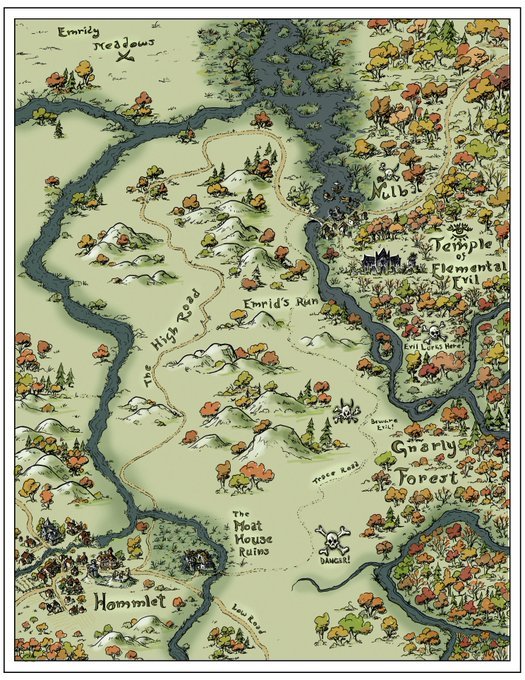
Amazing T1-4 map from Reddit user Valistrata
36 notes
·
View notes
Text
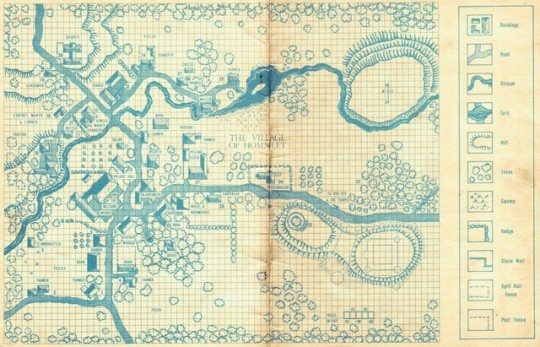
The Village of Hommlet
39 notes
·
View notes
Text
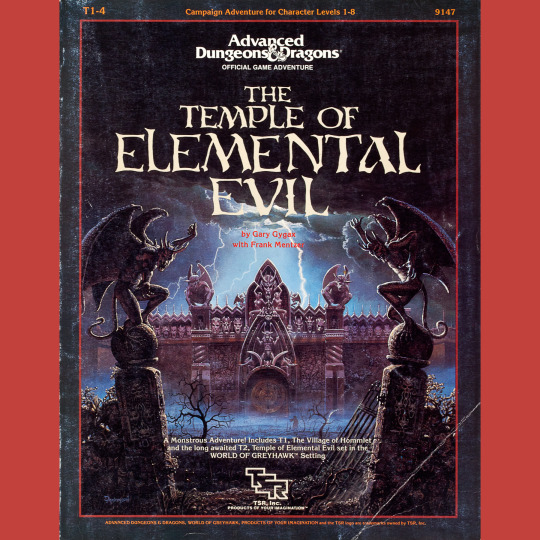




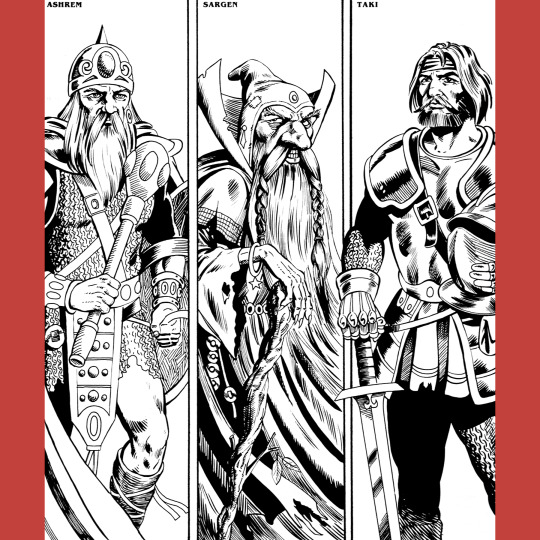
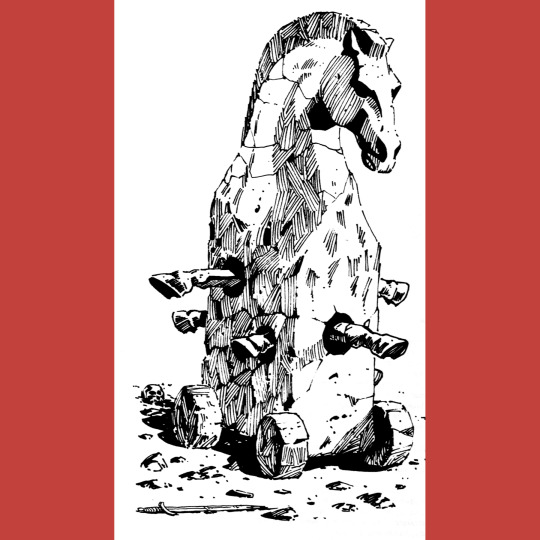
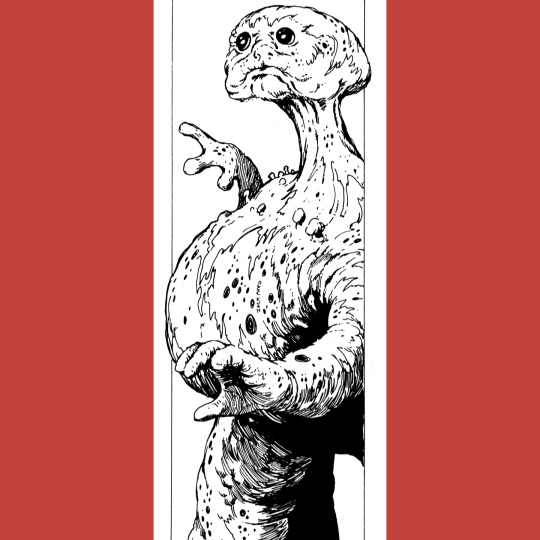
Supermodule week! The format — a perfect bound softcover, often with a folder in the back containing a large foldout map or a booklet of maps — was introduced with Lankhmar, but was frequently used by TSR from the mid-‘80s to the early ‘90s, particularly in reprinting older adventure material. As much as I love the Lankhmar book, I begrudgingly acknowledge that The Temple of Elemental Evil (1985) is probably the real star publication using the format.
Temple was supposed to be a couple of more traditional modules by Gary Gygax, starting with T1: The Village of Hommlet (1979), but he never got around to finishing the writing. Aside of Hommlet and some notes, the rest of this book is Frank Mentzer’s work. It’s OK! I like Hommlet a lot — a starter module with a seemingly friendly town (like the village in Jennell Jaquays’ Dark Tower, this is a facade) where 1st level characters can square off with a memorable villain (Lareth the Beautiful) in a ruined moathouse. They then move along to the seedy town of Nulb, where more agents of the Temple are gathering, before proceeding into the Temple itself. I like Nulb too. I’m a little mixed on the Temple.
It’s a megadungeon (though one on the smallish side), and I generally like those, but Temple doesn’t make sense to me, really. I mean, dungeons never do, but Temple particularly so, as it is both a staging ground for the forces of evil and a prison built by the forces of good. I also think “Elemental Evil” is a silly concept, but I do like the big twist at the end, the fact that the big bad is the demon queen of fungus, of all things. I also like that Zuggtmoy looks like a weird ET knock-off. I think the problem for me is that the towns are dynamic and full of potential, but the encounters in the temple feel very samey. It’s fine, its just no Barrier Peaks, you know? Nice Parkinson cover, though.
#roleplaying game#tabletop rpg#dungeons & dragons#rpg#d&d#ttrpg#Temple of Elemental Evil#Gary Gygax#Frank Mentzer#Keith Parkinson
252 notes
·
View notes
Text
408. Gary Gygax and Frank Mentzer - T1-4: The Temple of Elemental Evil (1985)
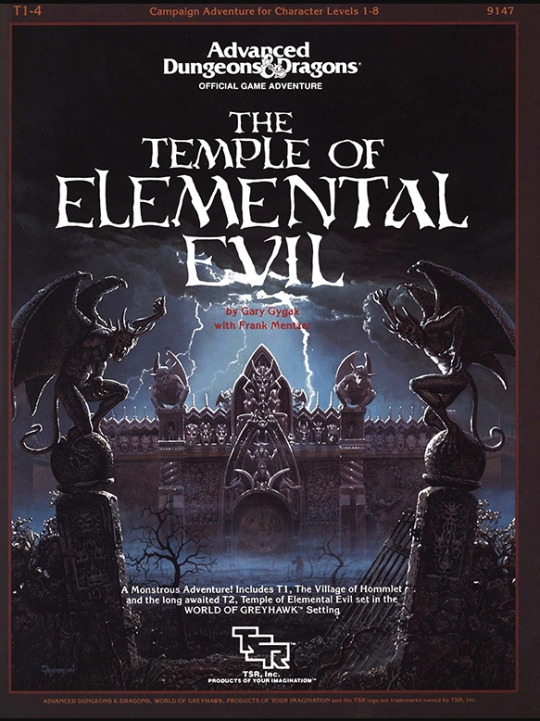
A true classic which spawned remakes up until our days and even a computer game, this is by far the longest adventure published in one go up until this time. Looking at the code T1-4 you might think that this is a compilation of reprints into one volume (as in the later GDQ1-7 module reprints that compose Queen of the Spiders) but you'd be wrong.
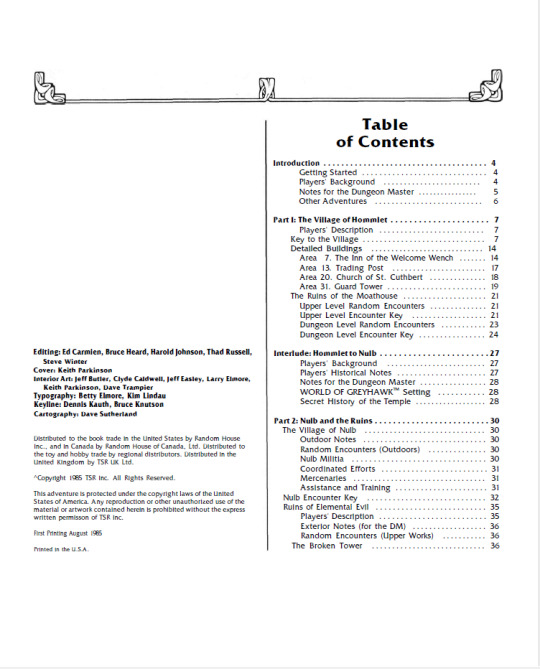
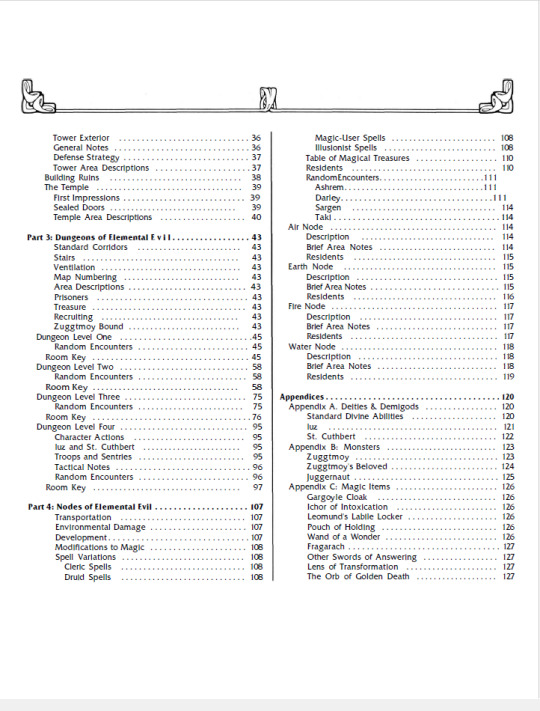
See, there was indeed a T1, The Village of Hommlet, and that does compose the opening bit of this adventure, but there is no T2, T3 or independent T4, those are all new to this edition and T2 to T4 is just the Temple of Elemental Evil, after a short trip to Nulb. The temple itself is one of the most classic of dungeon crawls, a sprawling place dedicated to cults of the four elements and then another deeper evil, the now infamous Zuggtmoy the Demon Queen of Fungi... remember that next time you have a mushroom pizza.
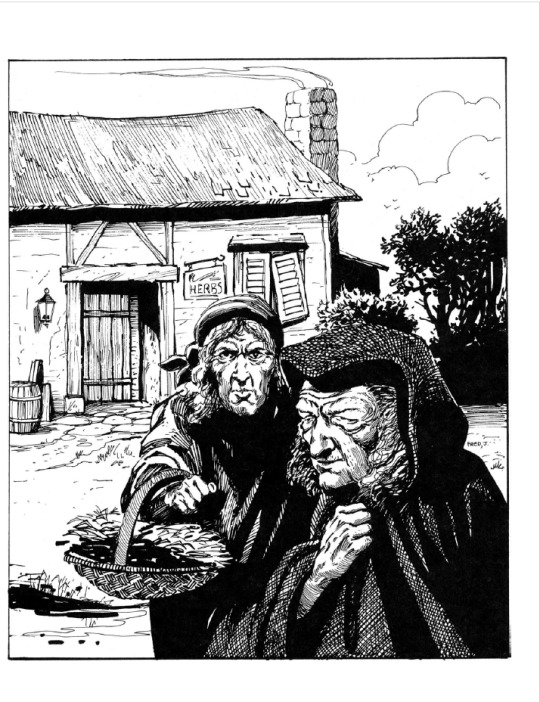
If you had bought T1 back in 1979 you were left with a starting area with a promising setting and nowhere to go after a short adventure in a moathouse, and then you were left with a six year wait for this massive piece while Gygax got a bit distracted with the growth of TSR and Hollywood, which is only natural. When this finally came out you could throw T1, as it was reprinted here, but also you had a great time in store for you and your player with nearly 140 pages of adventure at your fingertips.
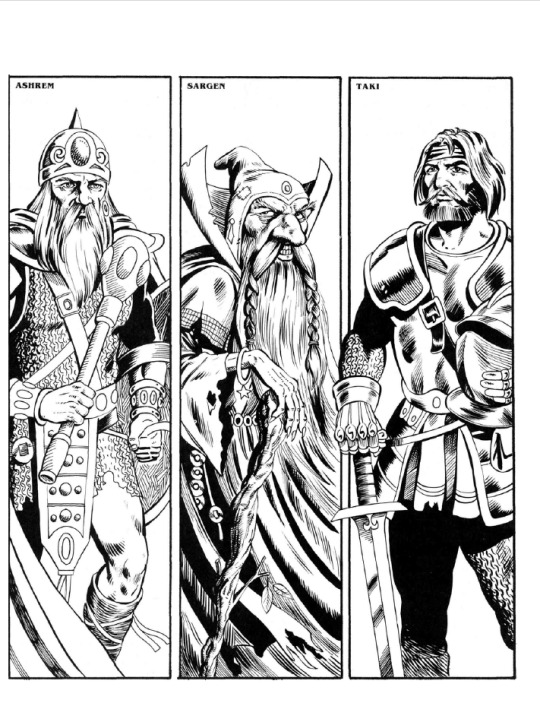
36 notes
·
View notes
Text
A quick blurb
The basic idea of this blog is simple: old DND had some really weird shit and interesting shit buried deep in its back catalogue, and I want to explore it. I really don't like how most review shows and books of classic DND modules are like. Here's Tomb of Horrors! Here's Village of Hommlet! Here's Keep on the Borderlands! We have heard of those. We know what those are. But like, when was the last time you saw someone talk at length about Valley of the Mage? Have you ever heard someone go to bat for the merits of The Halls of Beoll-Dur?
So, I want to go through every TSR module, in order, and pick through every adventure I can for its most interesting qualities. I'm going to give them a 5-star "rating" on how weird and interesting they are, cus it's fun to rate things. And maybe along the way I'll share some short history about things.
At 3am when I write this, my intention is to do a lil roundup of pre-G1 adventure modules, then jump into G1. I could cover modules in Dragon also in this blog, the first one is released about a month after G1 [Dragon 21, The Halls of Mystery), we will see how I feel about it after I wrap up G1. The thing about Dragon adventures, in my experience, is they tend to be very bland murder traps. Then again, it's a bit hypocritical to say that after salespitching you on seeing everything? I'm talking myself into this as I type.
4 notes
·
View notes
Text
Lolth didn't start out as a Misandrist?
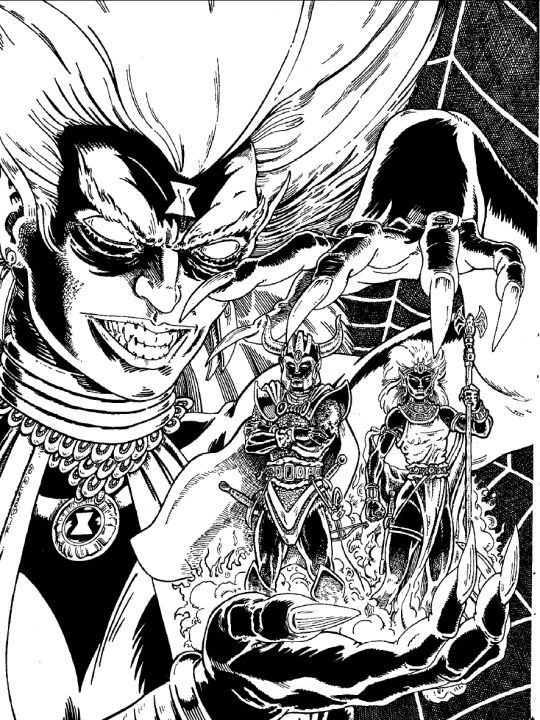
This might seem strange, but originally it was presented as unclear if Lolth was a misandrist, was behind the sexism in Drow society, and the misandry among Drow being itself much less severe. As stated from even late 1e AD&D article in Dragon Magazine #129 "Children of the Spider Goddess." (from which I take the main image):

And indeed, the text implies Drow are still less sexist and more meritocratic and egalitarian than many other societies, species and races, while still being an evil matriarchy.
This comes back to the Dark Elves and Lolth's first appearances in "Against the Giants" module trilogy (G1: "Steading of the Hill Giant Chief" and G3: "Hall of the Fire Giant") and Drow series ("D1 Descent into the Depths of the Earth", "D2 Shrine of the Kuo-Toa", "D3 Vault of the Drow and "Q1, Queen of the Demonweb Pits" (latter all collected into the Supermodule - "Queen of the Spiders") - were Drow Elves who worship the Elder Elemental God, still keep the matriarchal structure of their society.


These being the lore written by Gary Gygax (pretty much the creator or one of the creators of D&D)

It's also further evident in the connected series of modules The "Village of Hommlet"/"The Temple of Elemental Evil", were there is a lead human male cleric of Lolth, Lareth the Beautiful.
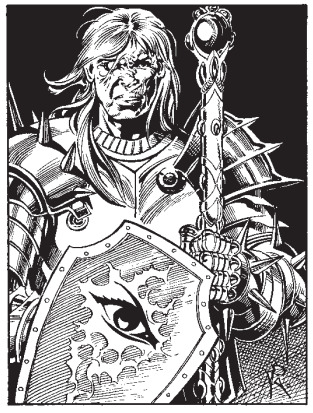
Lareth, no longer as beautiful as once
Lolth was even stated to be pissed of on whoever harms or kills Lareth:

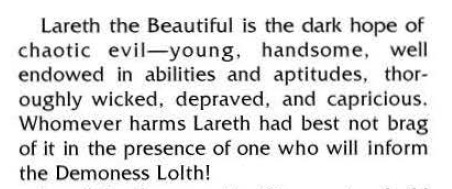
This was changed in Second Edition of Advanced Dungeons and Dragons, Lolth becoming increasingly misandrist (though even there still allowing male priests/clerics, as stated in 1991 "Drow of the Underdark" and 1998's "Demihuman Deities", specifically the latter stating 4% of Lolth Drow priesthood are male priests), though some writers tried to tone it down at least. Though only in Critical Role, Lolth is not as misandrist as in modern lore at least, calling back to her earliest characterization.
Still, I think it is interesting, seeing how the perception of Lolth in pop-culture, is different from how she started out, if due to old lore being forgotten in place of newer one, and also how R.A. Salvatore's very popular Drizzt novel series did portray Lolth as such (though even in some of his novels, till fairly recently, he did hint Lolth exaggerates/fakes how much of a misandrist she is).
#lolth#adnd#lloth#dnd#advanced dungeons & dragons#dungeons & dragons#d&d#ad&d#1e#2e#oldschool#drow#elf#elves#demon#queen#lord#misandry#change in characterization#critical role#queen of the spiders#against the giants#the temple of elemental evil#lareth#advanced#characterization marches on
37 notes
·
View notes
Text
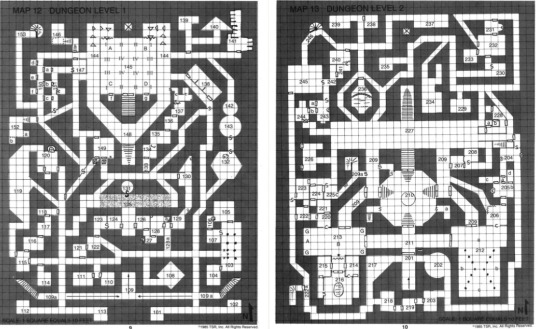
The sequel to 1979's T1 The Village of Hommlet, T1-4 The Temple of Elemental Evil released a mere 6 years later from TSR in 1985. Dungeon magazine declared it the 4th greatest D&D module in 2004. Here's the first and second level of the nefarious temple itself… it's elementary, on Map Monday aka Dungeon Day!!
2 notes
·
View notes
Text
AC in OSE, AD&D, and Modules
One of the biggest questions I keep seeing about Old-School Essentials is, "What vintage adventures are compatible with the system?"
The most common refrain to this is, any vintage TSR module--but be careful using AD&D modules, because the AC will be off by 1.
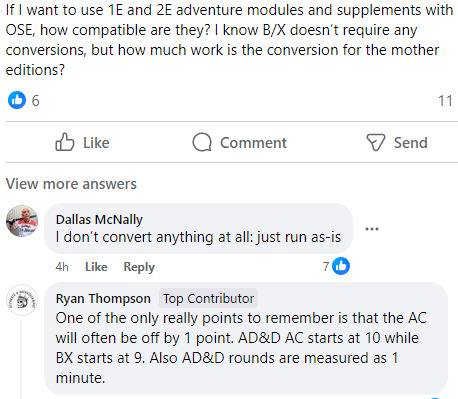
Let's put aside, for the moment, that one should never reference exact stats for a different game than the one you are currently running--if the module calls for an orc, you refer to the orc from Old-School Essentials, not the printed stats in the module. Even if they match, or OSE purports to be an exact match, you should abide by the stats of your system--not the module.
Also, if the AC is only off by 1, that's 5% chance on a d20. Will it break the game if the AC of the orc is 6 instead of 7? Absolutely not. It should be fine to just ignore.
But, I wanted to investigate the wisdom. Is it actually true that the AC is off by 1? Let's do the work.
To start with, we're gonna need the basic AC values from OD&D (I will get into why in a moment), B/X, OSE, and AD&D 1e's Player's Handbook. The OD&D values were actually quite hard to find; I couldn't find an exact match in the Men & Magic book to just tell me if Plate Mail was AC 2 or what. I couldn't find it quickly detailed in Chainmail or Greyhawk, either, and had to resort to Delving Deeper (I double-checked against Fantastic Medieval Campaigns for accuracy):
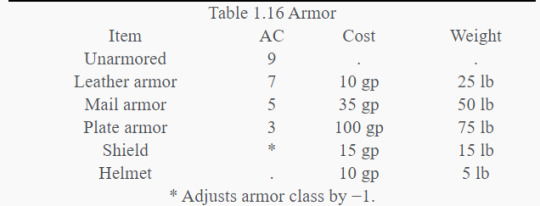

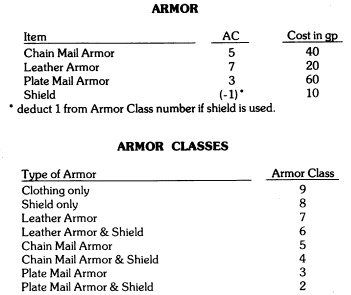
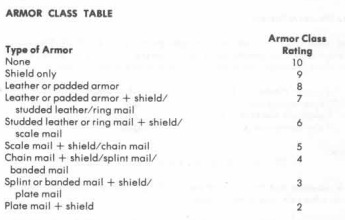
Here we see, indeed, that the base unarmoured AC for 1e is 10, rather than B/X and OD&D's 9. Fine, seems like everyone is right, and we could end it there. But...there needs to be more interrogation.
You see, AD&D 1e's Monster Manual was released in 1977, before the Player's Handbook and Dungeon Master's Guide. And I have long heard that the Monster Manual simply reused many of its stats from OD&D, rather than updating them to the AD&D AC standard--indeed, it may be that at the time of the Monster Manual's publication, the new standard had not even been created yet.
So, we need evidence. Let's grab orcs. They're in every edition of the game and we should be able to look at them easy.


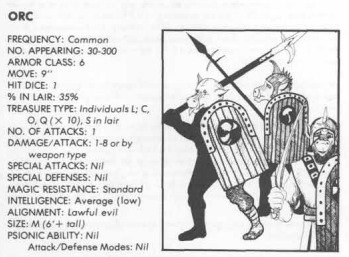
Wait. What the fuck? Why are orcs at 6AC still in AD&D? Leather armour is 6 AC in B/X and earlier, but 6 AC in AD&D is studded leather. Are AD&D orcs wearing studded leather? Or perhaps scale mail? Their description offers nothing.
It's possible the AC values for AD&D are supposed to simply be abstracted--orcs have 6 AC, and it's up to the DM to determine if this means they have studded leather, ring mail and shield, etc. Hey, who am I to argue?
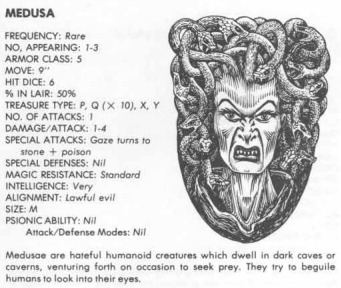

Some of the monsters just are straight up different, which helps no one.

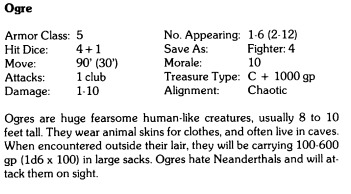
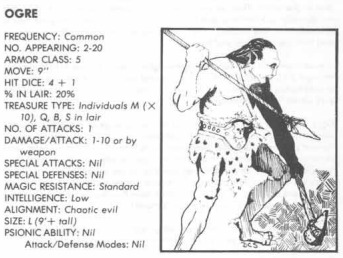
So, here's what we've figured out: The monsters in the AD&D 1e Monster Manual do in fact conform to OD&D and B/X AC standards. In most cases, where they aren't changed entirely to something clearly different, they opted to simply leave the AC the same and not bother to "adjust" to what it "should be" according to the new scale. In cases of humanoid men, typically they included a %-based table of what equipment they had; in these cases I assume you were to use the PC-facing armour class table to determine their AC. But an ogre just has AC 5, no matter if this scale is different.
But...this whole thing kicked off because of modules, not because of the AD&D Monster Manual. By my own admission, one needs not look at the AD&D Monster Manual at all, merely what is in the modules. Well, I wanted to do the research, because I need to know: Are the monsters as printed in modules bespoke, or are they simply reprinted from the Monster Manual?
To check this out, we're gonna start with a couple famous modules that are likely to be rec'd and used in OSE's format. Let's start with T1: The Village of Hommlet, and see if we can't find a few of the baddies we've already looked at.
Of first note, there's some bandits and included is the table of what AC they should have based on their equipment--helpful. Let's compare these AC against OSE:
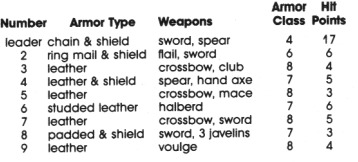
So, their AC actually is going off the AD&D PHB, meaning their AC is actually worse than if we just used the proper values for OSE. If you use these values, the bandits will actually be easier to hit than they were in AD&D...maybe. I gotta be real: I'm not an AD&D 1e expert and it's possible the to hit and STR modifiers are different enough to account for this.
Here's our ogre friend, with 5 AC as expected. The same as in OSE.
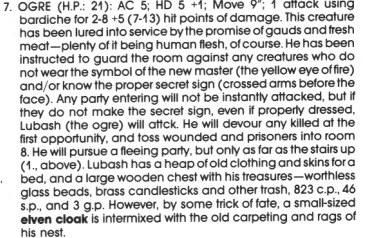
Let's move on to N1: Against The Cult of the Reptile God, a classic. This has no orcs but it does have goblins:

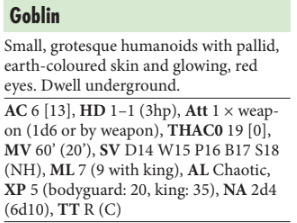
I could go on with more deep diving into old modules, but based on these two examples, I think it's safe to say that the standard was to just grab the stats from the Monster Manual and reprint them. So, even less than we've thought, do we need to worry about the difference in AC.
Want to read this article ONE DAY EARLY? Subscribe to the Tidal Wave Games Patreon!
0 notes
Note
Hey! Hope it's still wednesday ;) oops all steves this time!
Still Wednesday in my neck of the woods!
Make Me Write | Wip Wednesday
He sets the scene. "Your party has returned to the village of Hommlet where you had your first adventure together. It has been several years since your party first got its start and with nostalgia in your hearts and, more importantly the promise of a feast in your honor, you've agreed to return to the village to celebrate.
1 note
·
View note
Text
Hommlet Golden Brown Roasted Turkey with Sausage Stuffing and Drippings
Serves 4
Ingredients: Stuffing: 3/4 pound hearty white sandwich bread (8 to 10 slices), cut into 1/2-inch cubes (about 8 cups, lightly packed), 4 Tablespoons unsalted butter, 2 Teaspoons neutral-tasting oil, such as vegetable, canola, safflower, or grapeseed, 12 Ounces fresh sweet Italian pork sausage, casings removed, if necessary, 1 Yellow onion, chopped, 2 Celery stalks, trimmed and chopped, Kosher salt and freshly ground black pepper, 1 Tablespoon minced fresh thyme, 1 1/2 Teaspoons minced fresh rosemary, 1 1/2 Cups low-sodium chicken broth, 2 Eggs and 1/2 cup chopped fresh parsley.
For the Turkey: Kosher salt and freshly ground black pepper, 1 carrot, peeled and coarsely chopped, 4 Large, bone-in, skin-on turkey drumsticks (about 1 pound each) and 3 tablespoons unsalted butter, melted and cooled.
For the Gravy: 2 1/4 cups low-sodium chicken broth, plus more as needed, 6 Slices thick-cut bacon, 1 Carrot peeled and finely chopped, 1 Onion, finely chopped, 1 Teaspoon minced fresh thyme, 3 Tablespoons all-purpose flour, 1 Teaspoon fresh lemon juice, 1/4 Cup finely chopped fresh parsley and Kosher salt and freshly ground black pepper.
Make the Stuffing: Preheat the oven to 250 degrees Fahrenheit with a rack in the middle of the oven. Spead the bread cubes in an even layer on a large rimmed baking sheet and bake until dry and firm, about 45 minutes, stirring them several times. Transfer the bread cubes into a very large bowl and set aside.
Meanwhile, Prepare the turkey. Increase oven temperature to 400 degrees Fahrenheit. In a small bowl, mix together 1 1/2 tablespoons salt and 2 teaspoons pepper. Scatter the carrot, celery, and onion in a roasting pan or other stovetop-safe pan into which the drumsticks will fit.
Using your fingers, loosen but do not detach the skin from the drumsticks. Brush about half the melted butter under the skin, sprinkle each with some of the salt and pepper mix, and reposition the skin. Brush the drumsticks skin with the remaining butter and sprinkle each with some of the remaining salt and pepper mix. Arrange the drumsticks over the vegetables in the pan. Roast until an instant-read thermometer inserted into the thickest part of each drumstick registers 180 to 185 degrees, 1 to 1 1/4 hours. Transfer the drumsticks to a platter, cover loosely with foil and set aside.
While the turkey roasts, finish preparing the stuffing. Grease a broiler-safe 8-inch square (or similarly sized) baking dish with 1 tablespoon of the butter and set aside.
In a skillet over medium-high heat, warm the oil until shimmering. Add the sausage and cook, stirring and breaking up clumps into small crumbles, until some of the fat has rendered and the sausage is lightly, browned, 5 minutes. With a slotted spoon, transfer the sausage to paper towels to drain, leaving the fat in the skillet.
Add the remaining 3 tablespoons butter to the skillet and melt. Add the onion celery and 1/2 teaspoon salt and cook, stirring occasionally, until very soft, 5 to 7 minutes. Add the thyme and rosemary and cook stirring until fragrant, 1 minute. Add 3/4 cup of the broth and stir and scrape the bottom of the skillet to loosen any brown bits. Add this mixture, the sausage, 1 teaspoon salt, and pepper to taste to the bowl of bread and toss well to combine. Taste and adjust the seasoning with additional salt and pepper, if necessary.
In a small bowl, whisk the remaining 3/4 cup broth and the eggs until well combined. Add the egg mixture and most of the parsley to the bowl of bread mixture and toss to combine well. Pour the stuffing into the prepared baking dish, spread it into an even layer, cover the dish tightly with foil, and place it on a baking sheet. Put it in the oven with the turkey and bake until the stuffing is heated through and the moisture from the mixture is bubbling around the edges of the dish, 50 minutes.
Once the turkey is done roasting, make the gravy. Use a slotted spoon or skimmer to hold back the solids in the roasting pan and pour the accumulated liquid into a fat separator or measuring cup. Let rest until all the fat rises to the surface, 10 minutes. If you are using a fat separator, pour the drippings into another container and reserve the fat; if you are using a measuring cup, tilt it and use a wide, shallow soup spoon to skim the fat off the surface and deposit into another container. Reserve the remaining juices.
Set a strainer over a bowl. Place the roasting pan with the roasted vegetables over medium heat and cook undisturbed, until the vegetables begin to brown and stick to the pan, 3 to 4 minutes. Add 1 cup of the chicken broth and, using a wooden spoon, stir and scrape the bottom of the pan to loosen and dissolve the browned bits. Strain the liquid and discard the solids. Add the reserved juices liquid and enough chicken broth to equal 3 cups and set aside.
Wipe out the pan, set it over medium-low heat and fry the bacon, turning it over as necessary, until well-rendered and lightly browned, 13 minutes. Transfer the bacon to paper towels to drain, chop it, and reserve. You should have about 3 tablespoons of fat left in the pan.
Set the pan over medium heat and warm until the fat is shimmering. Add the carrot, celery, onion, and thyme and cook, stirring until the vegetables soften, 4 minutes. Add the flour and cook, stirring constantly, until dark golden and fragrant with a nutty aroma, 3 to 4 minutes. Switch to a whisk and whisking constantly, gradually add the strained broth mixture. Continuing to whisk, cook until the gravy thickens, 8 minutes. Add the lemon juice, parsley bacon and pepper to taste and whisk to combine. Taste and adjust the seasoning with salt and pepper, if necessary.
Once the stuffing is done, if you wish to crisp the skin on the underside of the drumsticks, preheat the broiler. Line a broiler-safe pan or rimmed baking sheet with foil, arrange the drumsticks with the browned sides down, and broil until the skin is browned and crisp, 5 to 7 minutes.
Remove the foil from the stuffing and fluff with a fork. If you'd like to crisp the surface of the stuffing, return the dish to the oven, and broil, checking frequently to prevent burning, until the surface is a shade darker and starting to crisp, 5 to 7 minutes. Sprinkle the stuffing with the remaining parsley. Serve the drumsticks piping hot alongside the stuffing and gravy.

Picture Credit: Goust18 games
Source: Player's Handbook
0 notes
Text
Greyhawk Campaign - Session 1 Report
[I am experimenting with my solo game rules and a pre-made adventure, "Return to the Temple of Elemental Evil" by Monte Cook.]
Flint, a ranger of human and elven ancestry, has arrived in the village of Hommlet, pursuing rumors of strange travelers along the roads. After his inquiries about the travelers were abruptly, albeit curiously, dismissed by the barkeep, Flint started a conversation with an illusionist named Nierethi Proscurian. Nierethi knew as much about the rumors of travelers as anyone else, but the mage did express an interest in exploring a nearby moathouse. Intrigued, Flint decided to join the mage.
0 notes
Text
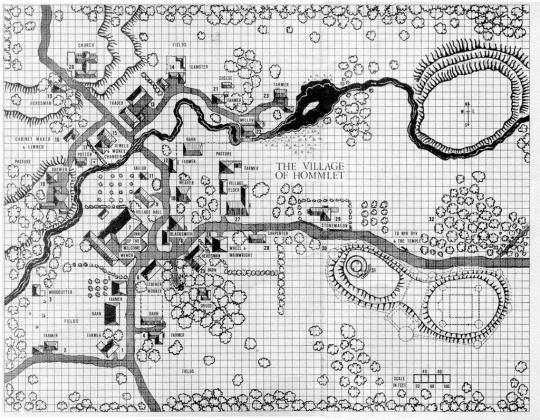
The Village of Hommlet
7 notes
·
View notes
Text
Download Now Heroes' Feast: The Official D&D Cookbook (Dungeons & Dragons) BY : Kyle Newman
(PDF Download) Heroes' Feast: The Official D&D Cookbook (Dungeons & Dragons) By Kyle Newman

Ebook PDF Heroes' Feast: The Official D&D Cookbook (Dungeons & Dragons) | EBOOK ONLINE DOWNLOAD
If you want to download free Ebook, you are in the right place to download Ebook. Ebook/PDF Heroes' Feast: The Official D&D Cookbook (Dungeons & Dragons) DOWNLOAD in English is available for free here, Click on the download LINK below to download Ebook After You 2020 PDF Download in English by Jojo Moyes (Author).
Download Link : [Downlload Now] Heroes' Feast: The Official D&D Cookbook (Dungeons & Dragons)
Read More : [Read Now] Heroes' Feast: The Official D&D Cookbook (Dungeons & Dragons)
Description
NEW YORK TIMES?BESTSELLER ? 80 recipes inspired by the magical world of?Dungeons &; Dragons?Ready?a tall tankard of mead and brace yourself for a culinary journey to match any quest!??Tom Morello, Rage Against the Machine?From the D&D experts behind?Dungeons & Dragons Art & Arcana?comes a cookbook that invites fantasy lovers to celebrate the unique culinary creations and traditions of their favorite fictional cultures. With this book, you can prepare dishes delicate enough to dine like elves and their drow cousins or hearty enough to feast like a dwarven clan or an orcish horde. All eighty dishes?developed by a professional chef?are delicious, easy to prepare, and composed of wholesome ingredients readily found in our world.Heroes? Feast?includes recipes for snacking, such as Elven Bread, Iron Rations, savory Hand Pies, and Orc Bacon, as well as hearty vegetarian, meaty, and fish mains, such as Amphail Braised Beef, Hommlet Golden Brown Roasted Turkey, Drow Mushroom
1 note
·
View note
Text
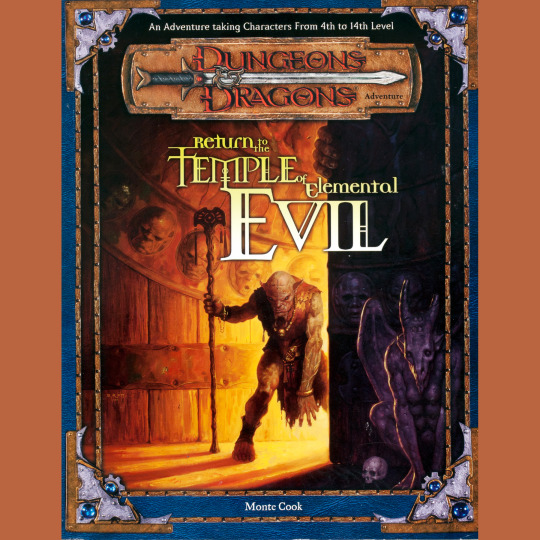



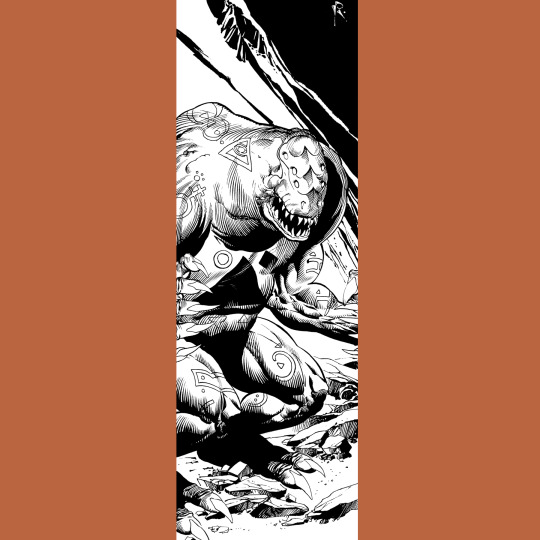

D&D continued to return to the locations of classic adventures after the advent of 3E. Slavers came next, but I don’t have that one (and am not gonna, I don’t enjoy the Slave Lords modules enough to want to revisit them). Then came Return to the Temple of Elemental Evil (2001).
If you recall from last year’s post on the original Temple of Elemental Evil, I don’t love it, basically. I like Hommlet and Nulb and the moathouse, but the temple itself, the elemental nodes, its function as both a prison for and hub of evil, it just doesn’t come together. So I should hate this, right? Nope! Monte Cook had a real talent for fiddling about with D&D as a body of canon lore and making things work. This book is no exception. Aside of the fact that it could stand to have 15-20% less combat encounters, I’d say it is pretty superior to the original in most ways!
Hommlet is still there, and the moat house. Lareth, too (though he is no longer bee-you-tee-ful). Nulb’s a ruin. So’s the temple, though there isn’t much there at the start. Instead, the second chapter leads to the Temple of All-Consumption and the cult of Tharizdun (thus tying things firmly to S4 and WG4). Only then does it become apparent what needs to be done to prevent the end of the world at the an excavation in the original Temple of Elemental Evil. It’s a good read and I expect it’s a good time to play through.
Brom’s on the cover. David Roach does good work inside — I believe this is one of the last D&D adventures with black and white interiors and honestly, that’s a tragedy.
And that’s it for returns, aside of the cyclical return to Castle Ravenloft. And, I guess, the bulk of the 5E campaign books. They’re always returning to familiar pastures.
#roleplaying game#tabletop rpg#dungeons & dragons#rpg#d&d#ttrpg#Return#Temple Of Elemental Evil#Monte Cook#Elemental Evil
103 notes
·
View notes
Text
84. Gary Gygax - T1: The Village of Hommlet (1979)

More of a campaign setting than an actual adventure, this feels like the starting area and base for what will be coming in T2, only in 1979 you'd have to wait 6 years for T2, The Temple of Elemental Evil, to actually come out.
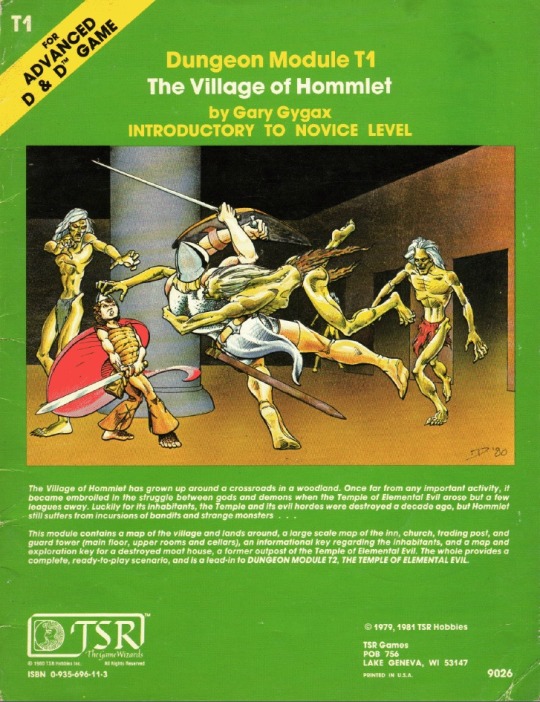
So you get a small village setting with every inhabitant, house and business described, with plotters and envoys of the evil temple as well as druidic forces and the lawful good followers of Greyhawk's St.Cuthbert as a setting for your adventure. There aren't really that many sidequests or things to do in the village except to understand the dynamics of the powers in the area. Some of the buildings, such as the inn, the church and the tower have detailed maps and more stuff going on in there. This is also an excelent setting for murder hobos as you get to know every little cent and bit of equipment that each innocent farmer has on the house or on his person, kind of rewarding the players for razing the town.

There's a small dungeon outside the town, an old Moathouse, full of all kinds of beasties and giant bugs and also some bandits and gnolls and such. However, unlike in modern adventures there is no hand holding here. There are no quests in the village directing you to the moathouse, no one even mentions it. You kind of have to guess. So it's a little sandbox module but a really important one, although the "small village starting area for low lvl PCs" might seems like a cliché today (as with Phandalin in the Starting set for 5e, for example), this is the very first time you get that. The start of a D&D staple. Now, only 6 years to go to actually get to the Temple of Elemental Evil.
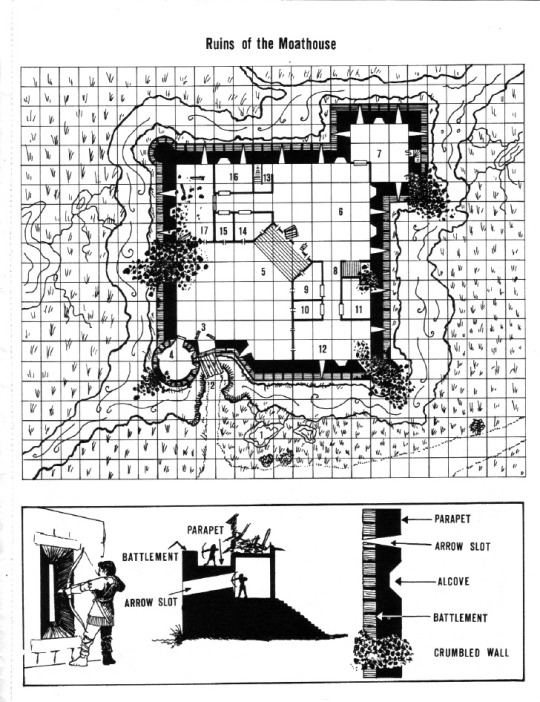
3 notes
·
View notes
